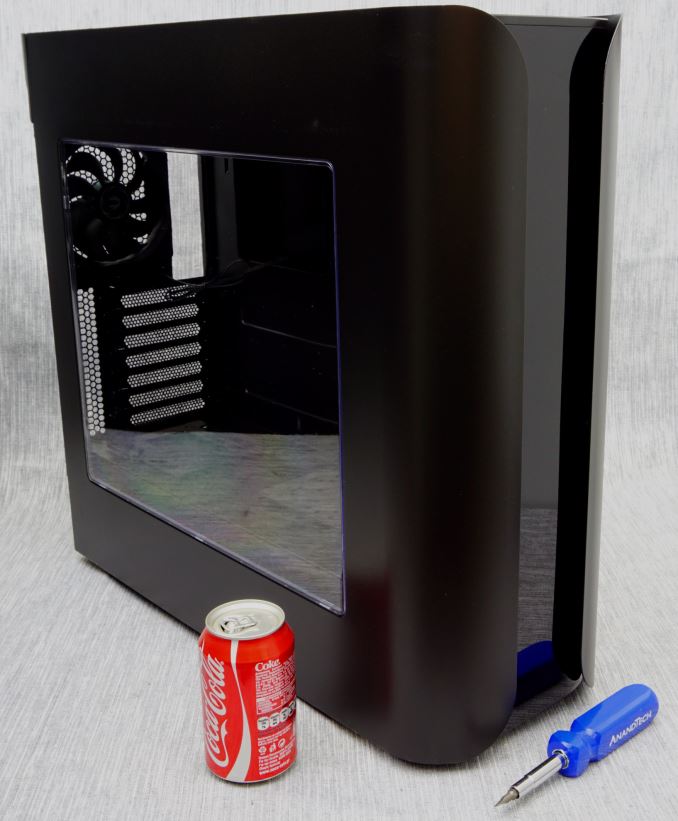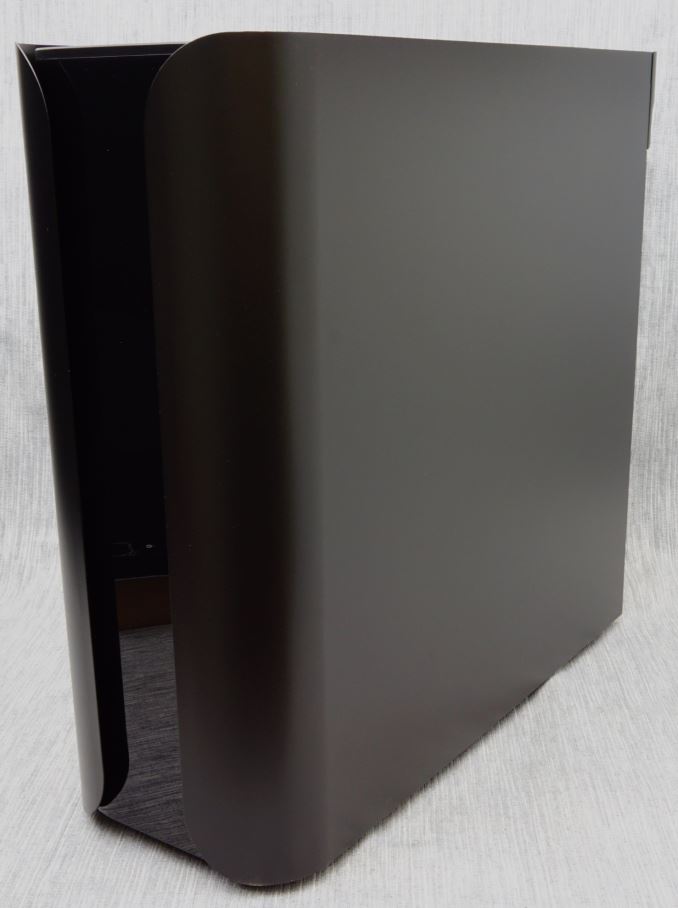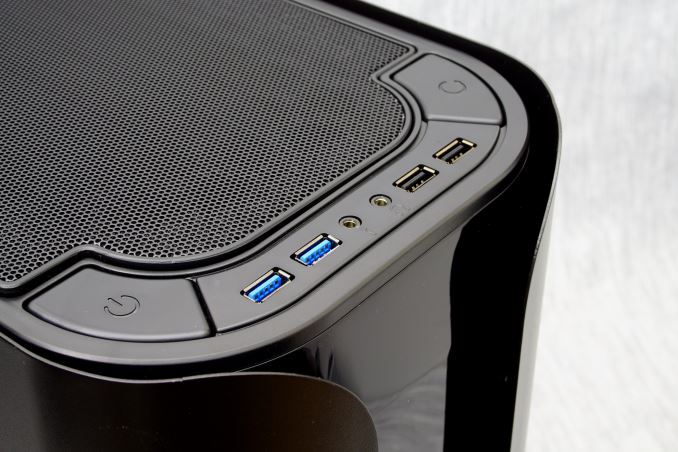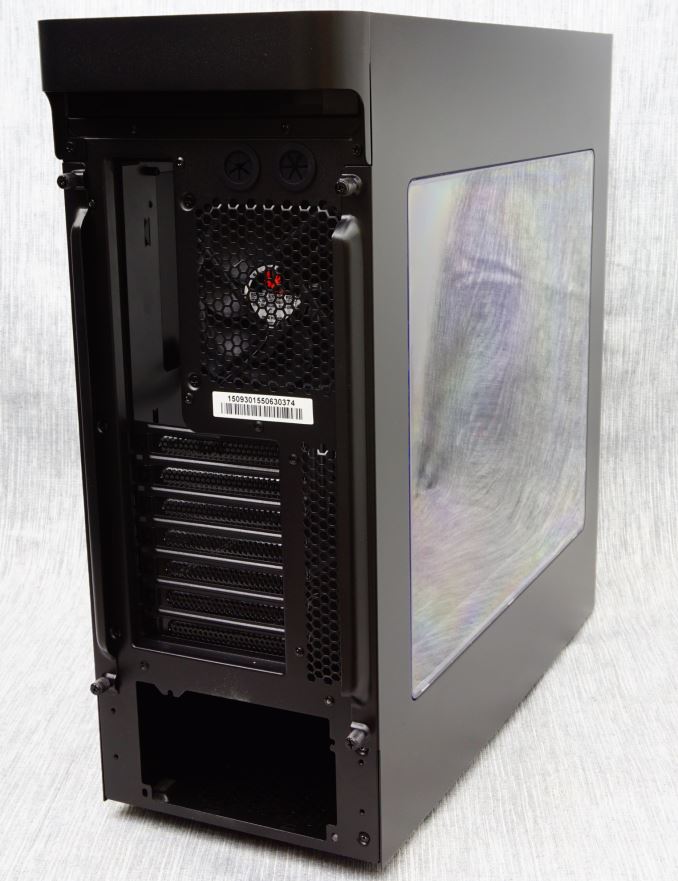The BitFenix Pandora ATX Case Review
by E. Fylladitakis on August 11, 2016 9:00 AM EST- Posted in
- Cases/Cooling/PSUs
- bitfenix
- ATX
- Case
The Exterior of the BitFenix Pandora ATX
The BitFenix Pandora ATX sports the same modern design that made the original Pandora famous, with smooth surfaces and side panels that extend to the front of the case as flaps. The design concept is not new as there were a few cases similar to the Pandora in the past (e.g. ThermalTake Armor), but the Pandora was the first where the flaps were a continuous part of the side panels, combined with having no external drive bays at all. The newer version that we are reviewing today is considerably larger than the original, measuring 51 cm tall, 20.3 cm wide and 55.8 cm deep (20 × 8 × 22 in), resulting to a volume of 57.8 liters, making it 40% larger than the mATX-compliant Pandora. It is also a slightly heavy case, tipping our scales at 9.72 kg when completely empty.
 11.2 oz can inserted as a size reference
11.2 oz can inserted as a size reference
BitFenix has designed only a single black version of the Pandora ATX at this point, with a windowed side panel. A smooth, satin black paint covers the entirety of the case with the sole exception being the glossy plastic front panel. The paint is relatively resistant to fingermarks but the glossy front panel is a true fingerprint magnet and can get dirty very easily. As there is nothing the user can physically interface with on the front panel, it should not be an issue, unless if there are young children or pets roaming about the area of the PC.
The front I/O ports and buttons can be found at the top side of the front panel. A large power on button can be seen on the far left side of the symmetrical array, followed by two USB 3.0 ports, 3.5mm audio jacks at the center, two USB 2.0 ports to the right and a large reset button to the far right. There is no door or cover for the USB/audio ports.
A look at the rear of the BitFenix Pandora ATX reveals that the PSU compartment is at the bottom of the case and the presence of a stock 120 mm exhaust fan. There are also two round holes with rubber grommets for liquid cooling hoses. The metallic brace that BitFenix supplies with the bundle goes in front of the PSU, exactly as the brace that can be seen pre-installed at the top of the case’s rear side.
The BitFenix Pandora ATX sits on four simple, round plastic legs with rubber anti-slip pads installed on them. With the exception of the nylon filter covering the PSU intake, there is nothing else of interest at the bottom of the case. The front air intake filter can also be removed by pulling it downwards from the gap between the chassis and the faceplate, something easy to be done with the case on a desk or table but requires the case to be lifted up or rolled to its side if it sits on the floor.
One unique feature of the Pandora ATX is the simple LCD screen on the front panel. By default, it is showing the company logo but the users can insert any photo/logo they wish, as long as it fits certain proportions and file formats. The software used to do this is very simple, perhaps even too simple for such a product. It has no interface at all, the user is simply required to drag and drop the picture file on the program’s icon. A little more sophisticated software with a basic user interface and minor editing options would certainly be much more effective.
















26 Comments
View All Comments
fanofanand - Thursday, August 11, 2016 - link
I understand that everything is designed to a price point, but how much more expensive could it have possibly been to go with all USB 3.0 instead of the 2 USB 2.0 ports? With backwards compatibility this makes no sense to me. USB 3.0 debuted at the end of 2009, we are talking almost 7 years here, I simply cannot understand this decision.woggs - Thursday, August 11, 2016 - link
All motherboards still have USB2.0 sockets and very few have more than one USB3.0 for the front panel. I was happy to see they put both because both is useful for the vast majority of folks. And, I wonder if they would sell you a USB3 replacement for those if you happen to have 2 USB3 sockets on your MB.fanofanand - Thursday, August 11, 2016 - link
I understand that all motherboards have 2.0 sockets but that is again, borne out of cost. With backwards compatibility there is literally zero reason for this. I understand why some legacy ports remain, like PS/2 (many cannot access the bios with a USB keyboard) but with USB it makes no sense. You say "I was happy to see they put both because both is (sic) useful" but there is literally no benefit to USB 2.0 over USB 3.0. I am unaware of a single device that works on USB 2.0 but not 3.0.DanNeely - Thursday, August 11, 2016 - link
I'd be happy if case makers would just offer double header cables with a USB3 and USB2 header on the end. If you've only got one 3.0 header on your mobo it's not that hard to remember which pair of ports are faster; and it gives full support if you've got two 3.x headers. For a forward looking setup today at least one C port would be nice; maybe 2 because actually filling up all 4 front ports isn't that common and it'd give better future proofing.Wider support from the mobo vendors is needed too. I was able to get 2x headers for my Haswell build; but that requirement severely limited my available mobo vendors (I ended up with an MSI board). (I also went with a Case Labs case that used a painted to match 3.5" bay device for its front panel support so that I can easily switch to a setup with C ports in the future; but realize that their cases are far to expensive for the average enthusiast.)
slyronit - Friday, September 2, 2016 - link
On my desktop PC, WIndows device recovery tool cannot flash my Lumia 950XL if it is connected to a USB 3.0 port (either on the front panel or the rear motherboard port). This has happened across Windows 8, 8.1 and now Windows 10, chipset/USB drivers always updated (Tried both the drivers from Windows Update and the Asus drivers). But for such cases, I can make do with a rear USB port.slyronit - Friday, September 2, 2016 - link
And this is all the more surprising, because the phone itself supports USB 3.0 and when connected to my SP3 dock USB 3.0 port, there's a noticeable speed improvement, compared to USB 2.0.RaichuPls - Thursday, August 11, 2016 - link
Some wireless mice/headsets don't play well with USB3.0, such as the Logitech G930 and G602. In my case, interference from USB3.0 ports severely reduce the wireless range of both.eek2121 - Thursday, August 11, 2016 - link
I have 2 devices that don't work with USB 3.0. A headset as well as a high end microphone. The need for USB 2.0 still exists. Manufacturers are aware of this and that's why they haven't dropped USB 2.0. Believe me, if manufacturers could drop USB 2 they would. Going all USB 3.0 would actually LOWER costs.fanofanand - Thursday, August 11, 2016 - link
Thank you eek and Raichu, I was unaware of those issues. I do stand corrected. :) How's this, I wish motherboard makers would at least provide an option with no legacy ports. For those completing a new build, the less legacy the better.kaidenshi - Sunday, August 14, 2016 - link
USB 3.0 isn't 100% backwards compatible across all devices, though. There are some USB 2.0 devices out there that don't enumerate properly or tend to lose communication when plugged into a USB 3.0 socket. Usually the product's support site will have a KB entry about this, and they will suggest using a 2.0 port. I've personally had this issue with a couple of different USB flash drives and with an Android cellphone.In short, USB 2.0 on a case in 2016 is a positive, not a negative thing.